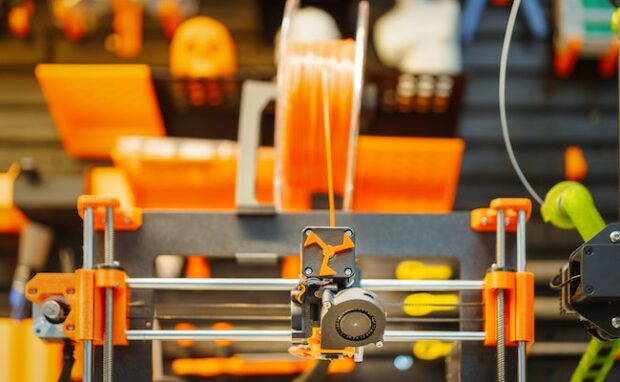NASA 3D printed a deep space rocket nozzle
NASA used 3D printing to create a rocket nozzle for deep space missions. It is part of the space agency’s Reactive Additive Manufacturing for the Fourth Industrial Revolution (RAMFIRE). The RAMFIRE rocket nozzle can withstand high temperatures and pressures. Soon, it could facilitate the production of spaceship parts.
The new rocket nozzle is made up of metal, a material unavailable for 3D printing at the time of writing. Yet, NASA found a way to form metal components without assembling them from many smaller parts. That is why various corporate and academic groups are excited to see how it will transform Earth’s manufacturing methods.
This article will discuss how NASA produced a 3D-printed rocket launch. Later, I will cover another NASA project using unconventional building materials.
How did NASA make a 3D-printed rocket?
The RAMFIRE project “seeks to help further increase performance and reduce cost by advancing novel additively manufactured (AM) aluminum materials.” The 3D Printing Industry website said it is a collaboration between NASA and the material developer Elementum 3D.
They created a new aluminum variant named A6061-RAM2 for the 3D-printed rocket nozzle. The space agency claims the new alloy can facilitate deep space missions.
The RAMFIRE team partnered with directed energy deposition (DED) specialist RPM Innovation to make special 3D printing nozzles. Most 3D printing methods pass a plastic or polymer filament through a hot nozzle to build layers.
Later, they cool and solidify into a person’s intended product. However, melting metal requires significant heat that could melt regular 3D printing nozzles. That is why the RAMFIRE variant has small internal channels that keep it cool during operations.
NASA tested the final rocketship nozzle at the Marshall Space Flight Center’s East Test Area. It used liquid oxygen, methane, oxygen, and hydrogen fuel configurations.
You may also like: Professor recycles coffee as 3D printing material
The component withstood pressure of 825 pounds per square inch (psi). “This test series marks a significant milestone for the nozzle,” stated RAMFIRE principal investigator Paul Gradl.
“After putting the nozzle through the paces of a demanding hot-fire test series, we’ve demonstrated the nozzle can survive the thermal, structural, and pressure loads for a lunar lander scale engine.”
Aerospace companies are evaluating this new 3D printing method to create satellite components. Also, they are exploring other use cases for its new material.
What are NASA’s other 3D printing projects?

“Industry partnerships with specialty manufacturing vendors aid in advancing the supply base and help make additive manufacturing more accessible for NASA missions and the broader commercial and aerospace industry,” stated RAMFIRE principal investigator Paul Gradl.
That is why it uses 3D printing for another project involving Moon houses. Raymond Clinton Jr., deputy director of the science and technology office at NASA’s Marshall Space Flight Center, sketched many ideas for space infrastructure.
However, lunar dust is one of his most significant problems. Moon particles could damage ordinary housing materials. Moreover, launching conventional construction materials and equipment to outer space is nearly impossible.
NASA partnered with construction technology firm ICON to find a solution. Consequently, the company turned the problem into a solution!
ICON will use lunar soil for its 3D printing home construction. The company will mix that dust into concrete on site to build everything from habitat to rocket landing pads.
You may also like: AI 3D printing program helps personalize models
This method is a quick, low-cost solution for housing problems on the Moon and the Earth. ICON CEO Jason Ballard said, “It’s a surprisingly natural progression if you are asking about the ways additive construction and 3D printing can create a better future for humanity.”
Yet, outer space conditions offer a unique challenge. Patrick Suermann, interim dean of the School of Architecture at Texas A&M University, explained, “Chemistry is the same up there, but physics are different.”
Also, he explained transporting materials from the Earth to space repeatedly is unsustainable. “There’s no Home Depot up there. So you either have to know how to use what’s up there or send everything you need,” Dr. Suermann stated.
Conclusion
NASA used 3D printing to produce a rocket nozzle that is more durable, heat-resistant, and pressure-resistant than previous components. As a result, rockets might be able to reach farther corners of outer space.
The 3D-printed rocket nozzle might function long enough to help astronauts learn more about heavenly bodies. More importantly, the new manufacturing technique may change how we make things on Earth.
For example, it could become faster to 3D print car parts instead of assembling them from multiple smaller components. Learn more about the latest digital tips and trends at Inquirer Tech.